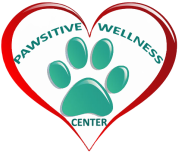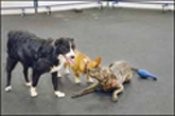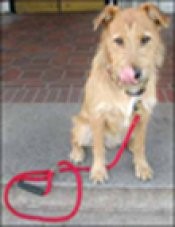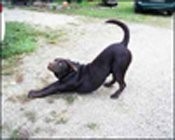|
Sitting/lying down/exposing underside: appeasing/deferent dog lowers body posture, exposing vulnerable parts Turning head away, averting eyes: appeasing/deferent dog avoids eye contact, exposes neck Avoidance Dog turns away; shuts down; evades handler’s touch and treats. Brow Ridges Furrows or muscle ridges in the dog’s forehead and around the eyes. Difficulty Learning Dogs are unable to learn well or easily when under significant stress. Digestive Disturbances Vomiting and diarrhea can be a sign of illness – or of stress; the digestive system reacts strongly to stress. Carsickness is often a stress reaction. Displacement Behaviors These are behaviors performed in an effort to resolve an internal stress conflict for the dog. They may be observed in a dog who is stressed and in isolation – for example a dog left alone in an exam room in a veterinary hospital – differentiating them from behaviors related to relationship. Blinking: Eyes blink at a faster-than normal rate Nose-Licking: Dog’s tongue flicks out once or multiple times Chattering teeth Scratching Shaking off (as if wet, but dog is dry) Yawning Drooling May be an indication of stress – or response to the presence of food, an indication of a mouth injury, or digestive distress. Excessive Grooming Dog may lick or chew paws, legs, flank, tail, and genital areas, even to the point of self-mutilation. Hyperactivity Frantic behavior, pacing, sometimes misinterpreted as ignoring, “fooling around,” or “blowing off” owner. Immune System Disorders Long-term stress weakens the immune system. Immune related problems can improve when overall levels of stress are reduced. Lack of Attention/Focus The brain has difficulty processing information when stressed. Leaning/Clinging The stressed dog seeks contact with human as reassurance. Lowered Body Posture “Slinking,” acting “guilty,” or “sneaky” (all misinterpretations of dog body language) can be indicators of stress. Mouthing Willingness to use mouth on human skin – can be puppy exploration or adult poor manners, but can also be an expression of stress, ranging from gentle nibbling (flea biting) to hard taking of treats, to painfully hard mouthing, snapping, or biting. Obsessive-Compulsive Disorders These include compulsive imaginary fly-snapping behavior, light- and shadow-chasing, tail-chasing, pica (eating nonfood objects), flank-sucking, self-mutilation, and more. While OCDs probably have a strong genetic component, the behavior itself is usually triggered by stress. Panting Rapid shallow or heavy breathing is normal if the dog is warm or has been exercising, otherwise can be stress-related. Stress may be external (environment) or internal (pain, other medical issues). Stretching
To relax stress-related tension in muscles. May also occur as a non-stress behavior after sleeping or staying in one place for extended period. Stiff Movement Tension can cause a noticeable stiffness in leg, body, and tail movements. Sweaty Paws Damp footprints can be seen on floors, exam tables, rubber mats.
0 Comments
Dogs Carnivores? Here is more proof that dogs do need a high protein diet and not carbohydrates. It took me a while to be convinced about feeding a raw diet but I have been totally on board with it for a while now and my dogs overall health is great. I was cooking their food before and I did use some organic grains that have a higher carbohydrate content. If your pet needs to lose some weight a raw meat and vegetable diet will sure help for the carbohydrate foods can cause the animal to gain weight since the dog doesn’t have the enzyme to digest carbohydrates.
Written By Dr. Karen Becker Recently I ran across an interesting white paper I wanted to share with everyone here at Mercola Healthy Pets. It was produced by Champion Pet Foods of Canada, makers of Orijen and Acana brands of dog and cat food. White papers such as this one, for those of you who may not be familiar, are typically informational marketing pieces and shouldn't be confused with scientific research studies. Wikipedia defines a white paper as "an authoritative report or guide helping readers understand an issue, solve a problem, or make a decision."1 The report is titled The Biologically Appropriate Food Concept and the Dietary Needs of Dogs and Cats, and while it is essentially an info-marketing piece, it contains a great deal of factual information I think pet owners will find useful. For example, the authors point out that despite thousands of years of domestication and our inclination to "humanize" them, dogs continue to share 99 percent of their DNA with wolves. And in fact, the Smithsonian reclassified the domesticated dog from its previous separate species of "Canis familiaris" to "Canis lupus familiaris" to more closely associate canine companions with their wolf cousins. The paper's authors also do a good job of reiterating and reinforcing the fact that dogs and cats are carnivores best served by a diet that matches their anatomies. How Nature Designs Carnivores The anatomical and physiological differences between herbivores, omnivores, and carnivores can be summarized as follows: Carnivores (Meat Eaters) (wolves, dogs, cats) Sharp, elongated teeth designed for tearing and killing prey, not grinding plants, plus jaws that move vertically and open widely, providing a smooth cutting motion, and the ability to swallow large chunks of meat. Killing prey, not grinding plants, plus jaws that move vertically and open widely, providing a smooth cutting motion, and the ability to swallow large chunks of meat. Short, simple and acidic digestive tracts that quickly and easily digest protein and fat from animal sources, plus kill bacteria found in decaying meat. No amylase in saliva. Herbivores (Plant Eaters) (cows, sheep) Square and flat molars that provide an ideal surface to crush and grind plants (but not meats), plus a lower jaw with a distinct sideways motion that facilitates the grinding needed to chew plants. Long digestive tracts up to 10 times their body length to break down plant foods. Saliva contains the carbohydrate-digesting enzyme amylase needed to digest starch. Herbivores methodically chew their food to ensure the thorough mixing with amylase. Omnivores (Both Meat and Plant Eaters) (pigs, bears, humans) Flat molars and sharp teeth developed for both grinding and tearing, plus the ability of the jaw to move sideways to grind food. Medium length digestive tracts that provide the flexibility to digest both vegetation and animal proteins. Saliva contains the carbohydrate-digesting enzyme amylase needed to digest starch. This table illustrates the key anatomical features that separate carnivorous dogs and cats from omnivores and herbivores, resulting in a natural adaptation for an almost exclusively meat based diet. 'Modern dogs of all breeds are not only capable of eating the food of their wild ancestors, but actually require it for maximum health.' The white paper discusses the dietary needs of dogs and cats, starting with the difference between types of protein and the fact that protein quality varies enormously depending on its source. Animal proteins are considered complete proteins for dogs and cats, while plant proteins are considered incomplete proteins. This is because animal proteins contain all the amino acids pets require, in the quantities needed for growth, maintenance, and overall health. Plant proteins, on the other hand (for example, corn gluten, soybean meal and plant protein isolates), do not contain all the amino acids in the right proportions a dog or cat needs, including arginine, taurine, methionine, lysine and tryptophan. Animal source fats are also essential in the diets of dogs and cats, as they provide essential fatty acids (omega-3, for example) and a concentrated source of energy. However, while both fats and carbohydrates provide energy, dietary fats are essential for dogs and cats whereas carbs are not. Carbs provide energy more rapidly than fats, but in dogs, carbohydrate loading generates an excessive amount of lactic acid in the muscles that can lead to hypoglycemia. As for omega-3 fatty acids, there are three kinds: ALA, which comes from plants (soy, canola oil and flax, for example), and DHA and EPA, which come from fish. Dogs and cats require DHA and EPA, but not ALA. Dogs and Cats Have No Nutritional Requirement for Carbohydrates According to PetfoodIndustry.com, AAFCO's 2010 Pet Food Nutrient Profilesand the National Research Council's 2006 Committee on Animal Nutrition conclude that dogs and cats do not require carbohydrates in their diets. And it's common knowledge that the natural diets of canines and felines contain almost no carbohydrates, with the primary source being predigested grains, fruits and veggies found in the stomachs of prey animals. The white paper authors state that, "Today's high carbohydrate pet foods lead to blood sugar fluctuations, insulin resistance, and are widely considered as a leading cause of obesity, diabetes and a host of other health problems in cats and dogs." Conventional dry dog foods are heavy on carbs, with most exceeding 40 to 50 percent in total carbohydrate content. This means that around half of typical dry dog food is composed of non-essential simple sugars – a fact that pet owners often aren't aware of because pet food manufacturers aren't required to list carbohydrate content on product labels. Carb intake above the daily needs of dogs (which is essentially zero) triggers internal enzyme factors to store the excess as body fat. The livers of adult dogs are able to easily synthesize glucose from protein and fats, so there is no need to supply carbohydrates in the diet. Despite Scientific Evidence That Dogs and Cats Are Carnivores, Dry Pet Food Manufacturers Persist in Adding Inappropriate Grains and Carbohydrates to Their Products The authors of the white paper concluded that the basic physiology of the dog and cat has changed very little over thousands of years of domestication, and though they differ in appearance from their wild cousins, their internal anatomy remains unchanged. Dogs are carnivores, not omnivores, and while they are very adaptable, just because they can survive on an omnivorous diet doesn't mean it's the best diet for them. The authors state, "With short digestive tracts and gastrointestinal systems, dogs and cats are adapted to metabolize animal flesh and fat, not grains and carbohydrates. Today's modern dogs (of any breed) are not only capable of eating the food of their wild ancestors, but actually require it for maximum health." These findings are well established within the scientific community. But it seems manufacturers of dry pet food are intent on feeding dogs and cats as if their digestive systems are similar to a human's, with a heavy emphasis on inappropriate grains and carbohydrates. While some like to claim that dogs and cats have "evolved" to eat kibble, this argument doesn't make sense in light of the fact that their digestive systems have not changed. And were such physiological changes to occur, they would require much longer than the time that dogs have been living with humans. I'm very much in agreement with the information contained in the Orijen white paper and am encouraged to see a commercial pet food manufacturer produce a comprehensive report containing factual information useful to pet owners. You can download the full report here. |
Blog CreatorMary DeRoche Archives
April 2024
Categories
All
|
DISCLAIMER: I, Mary DeRoche, am not a veterinarian and do not practice medicine. I do not diagnose, cure, heal, treat disease or otherwise prescribe medication. I assist people in working with their animals in correcting energetic imbalances in their pet’s bio-field that assists the body to release its innate healing ability. When the energy chi of the body is balanced and moving correctly, the body’s innate natural energy heals itself. All healing is self-healing. Animals are affected by their environment so I also include the pet parents in my work. Animals do pick up energy from their family and environment. I only recommend the use of therapeutic grade essential oils for your pets because therapeutic grade essential oils have been tested to guarantee that they are free of synthetics, additives, toxins and any other impurities, which can result in side effects and/or inconsistent results. Essential oils and supplements are recommendations to help boost the pet’s immune system.
I recommend that clients continue to see their pet’s regular veterinarian and follow their advice and my work is a complement to regular allopathic medicine. My spiritual energy work is not a substitute for conventional medical diagnosis or treatment for any medical or psychological condition. For such issues, you should seek the proper licensed veterinarian. I am a Healing Touch for Animals Practitioner and a Subtle Energy Practitioner and my work is spiritually and energetically based and I believe all healing is spiritual in nature. I do not make any promises, warranties or guarantees about results of my work, or of the energy sessions. The energy sessions help many animals but like any energy work, it might not work for everyone. The use of essential oils, herbs and supplements is to assist the pet with balancing chakra centers for proper energy flow or chi.
© 2013~2023 Pawsitive Wellness Center All Rights Reserved.
I recommend that clients continue to see their pet’s regular veterinarian and follow their advice and my work is a complement to regular allopathic medicine. My spiritual energy work is not a substitute for conventional medical diagnosis or treatment for any medical or psychological condition. For such issues, you should seek the proper licensed veterinarian. I am a Healing Touch for Animals Practitioner and a Subtle Energy Practitioner and my work is spiritually and energetically based and I believe all healing is spiritual in nature. I do not make any promises, warranties or guarantees about results of my work, or of the energy sessions. The energy sessions help many animals but like any energy work, it might not work for everyone. The use of essential oils, herbs and supplements is to assist the pet with balancing chakra centers for proper energy flow or chi.
© 2013~2023 Pawsitive Wellness Center All Rights Reserved.




 RSS Feed
RSS Feed